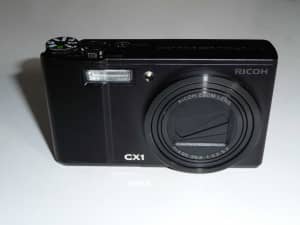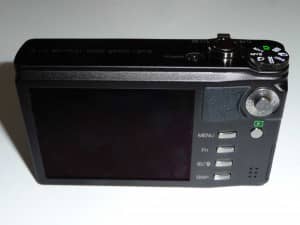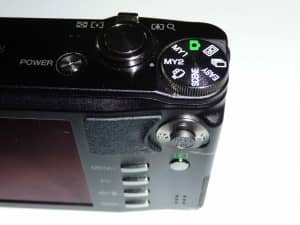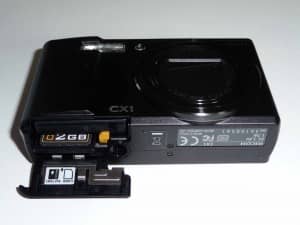Overview:
The Ricoh CX1 is a replacement for the Ricoh R10, and is available for £220.00 to about £260.00. A rival to the much hyped Panasonic DMC-TZ7, it boasts a 9MP CMOS sensor 7.1x optical zoom, and a raft of functions including face recognition, image stabilisation, even an electronic level.
I have been wielding the CX1 in the name of Gaj-It, and seeing if this camera is easy enough to use, and more importantly, whether the image quality is up to that of its rivals.
Review:
The Ricoh CX1 weighs approximately 200g with battery and memory card, and feels sturdy and robust in the hand. As you can see from the front-on photo, the flash is set into the hand hold, which made for a few photos where I had mistakenly covered it up.

Turning the camera round, you can see the control buttons and a pleasing 3″ screen. I am happy to report that the viewing angle is very good, with all the colour and clarity remaining even peering at it from sideways on. So holding the camera up over a crowd, you should still be able to see what’s going on. No viewfinder here, this isn’t something I’m particularly bothered about, and compact cameras seem to have them less and less, but if battery saving is something you are into, the option to turn that 3″ screen off, and be able to see where you are pointing the camera is not there.

There is a rubber grip for your thumb, that although quite small seems to be positioned so that you naturally gravitate to using it. The circular button to the right of the grip acts like a joy-pad, and you can use it to select frequently accessed features, you can also assign functions to it if the defaults are not to your liking.
You turn the CX1 on with a small power button on the top, and it happily bleeps into action. I have to admit to turning the camera off instead of taking the photo the once, but I think that says more about yours truly than about the camera. Once on, the display is bright and clear. A nice feature is the level that is displayed at the bottom. This makes sure that you are holding the camera flush to the horizon. When viewing photos back, that same mechanism, detects when you are holding the camera upside-down, and turns the photo for you, presumably an accelerometer.
Camera menus are becoming more and more complex, and hacking about those options can be a pain. The CX1 allows easy navigation via the four-way directional button next to the thumb pad. As well as the quick access features, it allows you to get to where you want to be in the menu quickly. The “Fn” button, performs a few functions as it’s assignable, but my favourite is the ability to target the Auto Focus, and/or the Auto Exposure. With the multifunction button you can move cross-hairs over the field of view on the display, and pick a point you would like the camera to focus on. This gives you that extra bit of control if you have the camera on a tripod for example. You can choose from a few aspect ratios and qualities, there is even a 1:1 ratio at 6MP, which is a format most people won’t have come across on their compact cameras. Nice to have, but I’m not sure it will see the light of day very often.

On the top of the camera is a solid dial that gives you eight options. Manual mode, the green camera symbol, give you all the options available to the camera. There is enough here to keep you going but not so much as it encroaches on the space that the cameras at the higher price points inhabit, namely exposure settings. MY1 and MY2 are for organising your own pre-sets. The settings you set up here are remembered, and you can revert to them any time you wish.
The video mode is just that, and allows you to take video at either 30fps or 15 fps, no big news here, and for a camera at this price point, I would expect to see a bit more. The scene mode gives you ten different pre-sets for various types of situation you may find yourself in, sports, portrait, landscape and nightscape to name four. There is a skew mode in here as well that allows you to straighten a rectangular object. For example, you could take a photo of a business card, and arrange it so it looks as if it had been taken straight on. I had varying levels of success with this.
Easy mode is point and shoot. Very good it is too. The camera is good at taking photos in this mode, and pictures seem sharp, although in low light it struggled a bit, but I certainly was happy to let the camera do the work. The penultimate setting is the Continuous Mode, and will take photos in quick succession. You can then select the photo that you feel is the best, or just have a stream of action shots perhaps.
The last mode, DR, is a bit clever. Essentially what it does is take two photos in quick succession, then merges the two for the best possible exposure. In theory this all sounds pretty good, but you either need a tripod or an extremely steady hand. Even with the image stabilisation switched on, you can get a blurry image. When it does take a photo properly, it does produce some very decent results.

Connectivity on the CX1 is an AV-out, and a Micro USB. Fine for plugging into the telly, and connecting to the computer. The camera can take SDHC cards, and has a 940mAh battery. Enough for approximately 270 photos, so they say.
Taking photos with the CX1 is a joy. It’s a very quick and responsive camera. I mainly used it in automatic mode, and pushing the button I noticed shutter lag only in the darkest of situations. The display on the back seems to suffer very little from blackout after you have taken a photo, if at all. The picture quality is phenomenal for this little camera, even at low ISO, I noticed very little noise, and very sharp images. I think this area is where Ricoh has focused most of it’s energy, using a quick CMOS sensor, and I’m sure some clever digital jiggery-pokery in the background to get things as fine and as stunning a possible.
The Gaj-It Verdict:
Design: 8/10
Usability: 8/10
Features: 7/10
Value: 8/10
We Say
A smashing little camera. Perhaps a little light on what you can do in manual mode, but the DR setting and the image quality more than make up for it. Add to that the simple interface and this camera is highly recommended. If you want a camera that’s simple to use, and produces stunning photos, then look no further.
Those of you interested can see some sample photos compared to a Panasonic DMC-TZ5 here.
